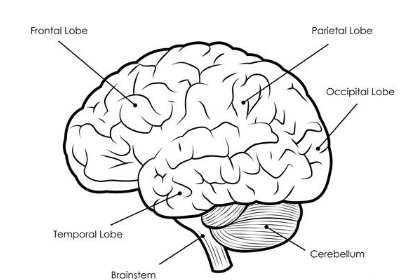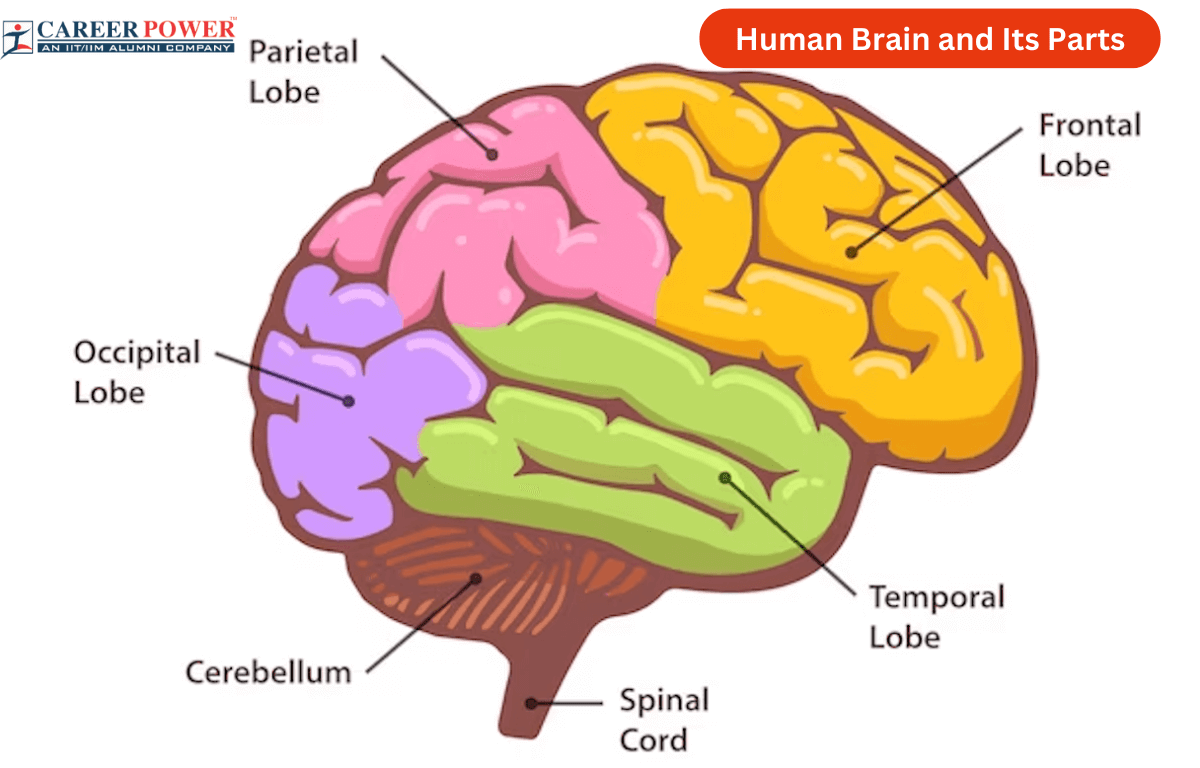The nervous system is divided into the Central nervous system and the Peripheral nervous system. The central nervous system consists of the Brain and spinal cord, while the peripheral nervous system consists of spinal nerves (that branch from the spinal cord) and cranial nerves (that branch from the brain). Our brain is situated inside our skull, right above our spinal cord. It’s protected by a strong bony box called the cranium.
The brain is a very interesting three-pound organ that plays several roles in the proper functioning of the body. It controls many different functions such as emotion regulation, sleep-wake cycle, and memory storage. The Human Brain is an important topic to be studied in Biology and in this article we have discussed each part of the brain in detail.
What is Human Brain?
The human brain is a part of biology, and here we are exploring it to gain a better understanding. The brain is the highest coordinating center in the body and receives information from all 5 sense organs. Our brain is situated inside our skull, right above our spinal cord. It’s protected by a strong bony box called the cranium. The human brain is enveloped by three membranes known as Meninges, which provide protection. These membranes include an outer layer referred to as Dura mater, a delicate middle layer known as Arachnoid, and an inner layer called Pia mater. The gaps between these membranes are occupied by Cerebrospinal Fluid, which serves to safeguard the brain against physical impacts.
Human Brain Diagram
The human brain diagram showcases the frontal lobe for decision-making, the parietal lobe for sensory processing, the occipital lobe for vision, and the temporal lobe for auditory functions. The brainstem regulates vital processes, while the cerebellum coordinates movement and balance.

Parts of the Human Brain
The brain is a complex organ responsible for controlling various body functions like processing sensory information, thinking, memory, and emotions. All the functions are carried out by different parts of the brain. The Human Brain is divided into three main parts:-
- Fore Brain- Cerebrum, Hypothalamus, Thalamus
- Mid Brain- Tectum, Cerebral Peduncles, Tegmentum
- Hind Brain- Cerebellum, Medulla Oblongata, Pons
The Forebrain consists of Cerebrum, Hypothalamus, and Thalamus. The midbrain is further divided into Tectum, Cerebral Peduncles, and Tegmentum. The Hindbrain consists of three centers: Pons, Cerebellum, and Medulla oblongata. Now let us briefly describe all three parts of the Brain.
| Different Parts of the Human Brain | ||
| Parts of the Brain | Description | Main Function |
| Hind Brain | Located at the back of the Brain. | Controls basic life functions like breathing, heart rate, and balance. |
| Mid Brain | Found in the middle of the brain. | Acts as a relay station for auditory and visual information. It also controls eye movements. |
| Fore Brain | The largest part is located at the front of the brain. | Responsible for higher cognitive functions like thinking, decision-making, and emotions. It includes the cerebrum. |
Parts of the Human Brain and Their Functions
As now we all know that the brain is divided into three parts Cerebrum, brainstem, and cerebellum. Each part plays its own role in the proper functioning such as breathing, coordination of the muscles, maintaining posture, digestion, heart rate, body temperature, and movement of the body. Here is a brief detail about the different parts of the brain and their functions.
1. Forebrain
The forebrain is the main thinking part of the brain, it is also known as Procephalon. It is the largest part of the brain in vertebrates. All the voluntary actions, consciousness, emotions, and memory of the body are coordinated by the forebrain.
The forebrain is divided into 3 parts:-
- Cerebrum
- Hypothalamus
- Thalamus.
Cerebrum
The cerebrum forms the main part of the brain. It is the most advanced and developed part of the human brain. The cerebrum is divided into two halves which are known as the left and right cerebral hemispheres, which are further connected by a bundle of nerve fibers called Cerebral callosum. The cerebral hemisphere is covered by a layer of cells called the cerebral cortex. Cerebrum is further divided into eight different parts, which have been discussed below-
1. The frontal lobe: The frontal lobe in the forebrain is responsible for various cognitive functions like reasoning and problem-solving. It is situated in the front of each cerebral hemisphere.
2. Parietal Lobe: Parietal Lobe helps in the processing of sensory information related to touch, pain, temperature, pressure, etc. It is situated just behind the frontal lobe.
3. Temporal lobe: The Temporal lobe helps in the regulation of emotions, memory, and auditory processing. It is positioned on the brain’s sides.
4. Occipital Lobe: The Occipital Lobe controls the visual processing which helps us to understand the visual information. It is located at the backside of the cerebrum.
5. Insular Cortex: The Insular Cortex is also known as Insula, it is involved in many functions such as self-awareness, emotion regulation, and many more.
6. Cerebral Cortex: It controls sensory processing, voluntary actions, and higher cognitive functions. The cortex is the outer layer of the cerebrum which is made up of grey matter.
7. Basal Ganglia: The Basal Ganglia helps in motor control, habit formation, and emotion regulation.
8. Limbic System: The limbic system involves the: Amygdala (which helps in Emotions), Hypothalamus (Regulation of physiological processes and emotions), and Hippocampus (Memory).
Thalamus
The thalamus is located deep within the cerebral hemisphere. Thalamus is a fundamental structure that facilitates communication between different brain regions and contributes significantly to our motor control, and overall cognitive processes. Like a busy relay station, the thalamus receives and passes on sensory information to the brain. It acts as a gatekeeper, regulating the flow of information to the cortex. Damage to the thalamus can lead to neurological disorders like sensory deficits, motor control issues, or disturbances in sleep patterns.
Hypothalamus
The hypothalamus is a small but crucial part, placed at the base of the thalamus. The hypothalamus controls various physiological processes such as body temperature, hunger, thirst, sleep, etc. The hypothalamus communicates with the other brain regions such as the pituitary gland and the brainstem to control all the functions. It plays a crucial role as a link between the nervous system and the endocrine system. If for any reason the hypothalamus gets damaged it can lead to various disorders, which include hormonal imbalance, disturbance in sleep, and appetite.
Working of Forebrain
The cerebrum or forebrain receives sensory information through the receptors of the sense organs. The cerebrum receives information and uses past experiences to make decisions it believes are correct. It then sends out instructions to the motor area (which controls the movement of voluntary muscles), so that the body can provide an appropriate response.
Importance of Forebrain
- The Forebrain processes sensory information from the environment, it also interprets stimuli such as touch, sight, smell, and sound.
- It’s the brain’s main thinking part.
- Memory formation and storage are closely linked to the cerebrum, particularly the Hypothalamus which is responsible for the storage of long-term memories.
- The forebrain plays a very important role in the coordination of voluntary muscles.
- The Limbic system of the Forebrain is responsible for emotions, motivation, and mood regulation. This area helps in forming emotional responses and also influences our behavior.
2. Mid Brain
The midbrain is located between the Forebrain and Hindbrain. The midbrain, also known as the mesencephalon, manages reflex movements of the head, neck, and trunk when we see or hear things.
The Midbrain is divided into three different parts and all three parts have their own functions:-
- The Tectum
- The Cerebral Peduncles
- The Tegmentum
Tectum
The tectum is located in the upper part of the midbrain and has four round structures called Colliculi. The colliculus is also further divided into Superior Colliculus and Inferior Colliculus. The superior colliculus is responsible for the visual processing, while the inferior colliculus is responsible for the Auditory processing.
Cerebral Peduncle
The cerebral peduncle is the bundle of nerve fibers connecting the brainstem to the cerebral cortex, facilitating communication between different brain regions.
Tegmentum
The Tegmentum is the ventral part of the midbrain and has many different structures, each structure has its own role in the proper functioning of the brain. It controls voluntary movements, critical motor controls, and pain modulation, and it also plays a crucial role in motivation.
Working of Midbrain
The midbrain works through a complex network of interconnected structures and pathways that facilitates various functions within the brain and the body. The midbrain working involves receiving and processing sensory information.
Importance of the Midbrain
- The Midbrain is involved in pain modulation and regulates the perception of pain.
- The midbrain controls eye movement as the Oculomotor nerve (responsible for the majority of eye movements) originates from the midbrain.
- The midbrain also helps maintain consciousness and alertness as it regulates the sleep-wake cycle.
- It also helps in motor control.
3. Hind Brain
The Hind Brain is located at the lower back of the brain. The hindbrain includes most of the brainstems and a dense coral-shaped Cerebellum. It helps in maintaining the respiratory rhythm. The Hindbrain is divided further into three major structures, and each of them plays a very important role in the proper functioning of the brain
- Cerebellum
- Medulla Oblongata
- Pons
Cerebellum
The cerebellum helps in maintaining Posture, balance, and skilled movements. It receives sensory information from various parts of the body. It is located just under the cerebrum at the back of the brain.
Medulla Oblongata
Medulla Oblongata is the lowest part of the Medulla. It has a very important role in controlling involuntary actions such as breathing, heart rate, blood pressure, and digestion. It also Besides its other functions, it acts as a pathway for nerve fibers connecting the brain and spinal cord, linking the two together.
Pons
Pons contains important nerve centers and acts as a bridge, which connects various parts of the brain. Pons is located above the Medulla. It plays a relaying role between the cerebrum and cerebellum.
Importance of the Hindbrain
- The hindbrain is responsible for controlling various involuntary functions.
- Without proper coordination from the hindbrain, our movement would be jerky, and imprecise.
- The hindbrain serves as a bridge connecting the cerebrum and cerebellum.
- It also regulates the sleep-wake cycle.
Different Functions of the Human Brain
The brain is the central information processing organ of the human body which performs as the ‘command and control system’. The Human Brain controls almost every voluntary function of the human body, it even controls the functioning of involuntary organs (such as lungs, heart, kidney, etc). Some of the other functions of the brain are mentioned below-
- The voluntary movements
- Balance of the body
- These are the important organs in our body, like the lungs, heart, and kidneys, that work automatically without us having to think about it.
- Thermoregulation
- Hunger and thirst
- Circadian (24-hour) rhythms of our body
- Activities of several endocrine glands
- Human behavior



 50 Vegetables Name for Kids in English a...
50 Vegetables Name for Kids in English a...
 Food Chain: Definition, Types, Examples,...
Food Chain: Definition, Types, Examples,...
 Human Respiratory System: Definition, Di...
Human Respiratory System: Definition, Di...













